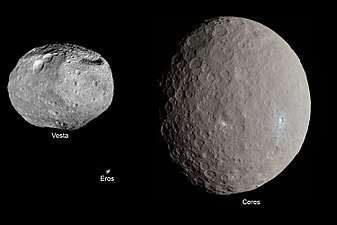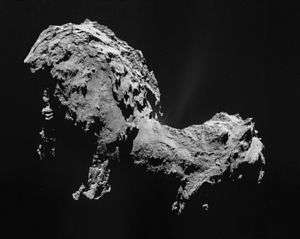DESTINY+
DESTINY+ (Demonstration and Experiment of Space Technology for INterplanetary voYage Phaethon fLyby dUSt science) is a planned mission to flyby the meteor shower parent body 3200 Phaethon, as well as various minor bodies originating from the "rock comet". The spacecraft is being developed by the Japanese space agency JAXA, and will demonstrate advanced technologies for future deep space exploration. As of 2017, DESTINY+ is planned to be launched in 2022.[2]
| Names | Demonstration and Experiment of Space Technology for INterplanetary voYage Phathon fLyby dUSt science |
|---|---|
| Mission type | Technology demonstrator, recoinnaissance |
| Operator | JAXA |
| Website | destiny |
| Mission duration | total: ≥4 years cruise: ≈2 years[1] |
| Spacecraft properties | |
| Bus | SSS (small scientific satellite) by ISAS[1] |
| Manufacturer | JAXA |
| Launch mass | 480 kg (1,060 lb) including 60 kg xenon and 15.4 kg hydrazine [2] |
| Power | 4.7 kW [2] from solar panels |
| Start of mission | |
| Launch date | 2022 (planned) |
| Rocket | Epsilon |
| Flyby | |
| Transponders | |
| Band | X band [2] |
Small-class Science Program | |
Overview
DESTINY+ will be launched from Uchinoura Space Center by an Epsilon rocket in 2022 into low Earth orbit, and will spend 1.5 years raising its orbit with ion engines.[2] A Lunar flyby will accelerate the probe into an interplanetary orbit. During this cruise time it will flyby a few near Earth objects for study, including the transition body 3200 Phaethon, as well as measure interplanetary and interstellar dust.[3]
The probe's ion engines have the capability to perform another orbit transfer to study additional objects.[1]
Objectives
DESTINY+ will be a technology demonstrator to further improve operations of low cost solar electric propulsion in deep space. It will also demonstrate innovative light-weight solar array panel technology. The scientific aspect of this mission is to understand origin and nature of dusts, which are key sources of organic compounds to Earth. It will also observe dusts from comet/asteroid 3200 Phaethon using a dust analyzer and will map its surface using a multiband telescopic camera to understand the mechanisms of dust ejection.[2] The spacecraft will flyby as close as 500 km (310 mi) from 3200 Phaethon.[2]
Spacecraft
DESTINY+ will use ultra light-weight solar panels and heat-actuated folding radiators, along with compact avionics. The spacecraft is designed to tolerate a radiation dose up to approximately 30 krad by using a 3 mm aluminum shield.[2]
Propulsion
The spacecraft will be propelled by four μ10 solar electric ion engines,[2] as used by Hayabusa and Hayabusa2, but while its predecessors operated only up to three engines simultaneously, DESTINY+ will use all four simultaneously[4] for a total thrust of 40 mN (specific impulse: 3000 s; acceleration: 83 μm/s2; power: 1670 W.[2]) The total dry mass (excludes xenon propellant) of the ion engine system is 59 kg (130 lb).[2]
Payload
DESTINY PLUS will cary three scientific instruments:[3]
- DESTINY Dust Analyzer (DDA) — The DESTINY Dust Analyzer (2.7 kg) will be provided by the German Aerospace Center (DLR),[5] and is being developed by the University of Stuttgart.[2]
- Telescopic Camera for Phaethon (TCAP) — The telescopic camera has a mass of 15.8 kg.[2]
- Multiband Camera for Phaethon (MCAP) — The multiband camera has a mass of 3.5 kg and will detect light in 390 nm, 550 nm, 700 nm, 850 nm wavelengths.[2]
See also
- Lucy – planned NASA mission to flyby multiple Jupiter trojans
- OKEANOS – proposed JAXA Jupiter trojan flyby mission using solar sail/solar electric propulsion hybrid
- OSIRIS-REx – NASA sample-return mission to the carbonaceous asteroid 101955 Bennu
- Rosetta – ESA mission to comet 67P/Churyumov–Gerasimenko
References
- DESTINY Mission Overview. (PDF) Yasuhiro KAWAKATSU. JAXA
- Toyota, Hiroyuki; Nishiyama, Kazutaka; Kawakatsu, Yasuhiro (15 August 2017). "DESTINY+: Deep Space Exploration Technology Demonstrator and Explorer to Asteroid 3200 Phaethon" (PDF). Low-Cost Planetary Missions Conference. Retrieved 2017-09-21.
- Studies on Solar System Explorations using DESTINY: the Demonstration and Experiment of Space Technology for Interplanetary Voyage. (PDF) Takahiro Iwata, Yasuhiro Kawakatsu, Go Murakami, Yuichiro Ezoe, Shingo Kameda, Kunihiro Keika, Tomoko Arai, Shuji Matsuura, Takanao Saiki, Takeshi Imamura, Kazunori Ogohara, Akira Oyama, Toshinori Ikenaga. ISTS Special Issue: Selected papers from the 30th International Symposium on Space Technology and Science. Vol. 14 (2016) No. ists30; DOI: http://doi.org/10.2322/tastj.14.Pk_111
- "DESTINY+: Technology Demonstration and Exploration of Asteroid 3200 Phaethon" (PDF). ISAS/JAXA. 20 September 2017. Retrieved 2017-09-22.
- "DLR-JAXA Joint Statement concerning the bilateral cooperation" (Press release). JAXA. September 10, 2017. Retrieved September 21, 2017.
External links
- Official project site (in Japanese)



